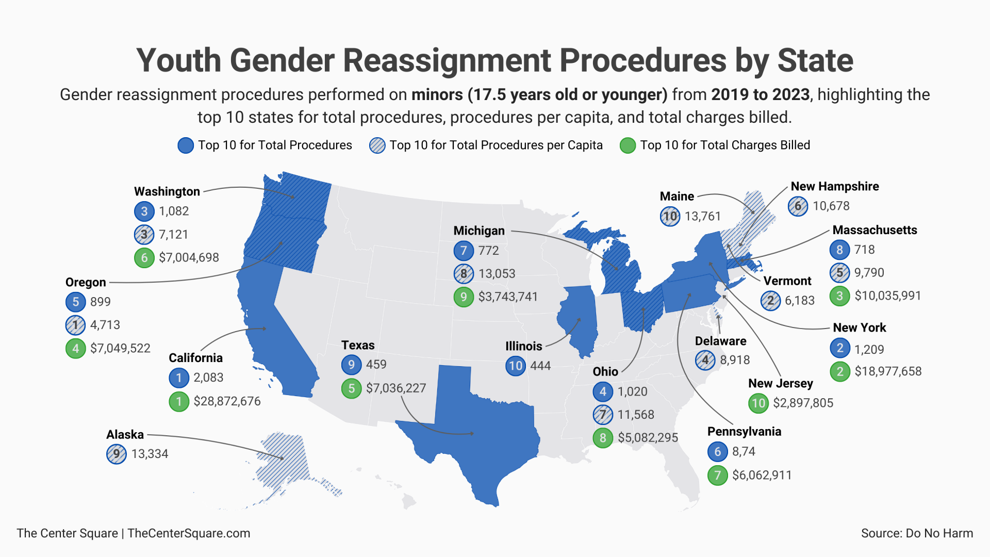Database: More than 13,000 gender reassignment procedures on minors between 2019-23

40% were performed in just four states: California, New York, Washington and Ohio
(The Center Square) – Sex reassignment procedures and surgeries on children have gained national prominence in recent years, and half of U.S. states now have laws passed either restricting or banning them.
Newly released data provided by the nonprofit Do No Harm indicates that the number of procedures overall has increased since at least 2019.
While many of those procedures from 2019 through 2023 occurred in states known for championing the right of juveniles to have irreversible medical procedures done even without parental knowledge or consent, such as California and Washington, some states that have since placed restrictions or outright bans on the procedures also have some of the highest numbers.
According to Do No Harm, between 2019 and 2023, there were at least 13,394 gender reassignment procedures nationwide on individuals 17.5 years old or younger, with the youngest 7 years old.
“Procedures” are defined as either the use of puberty or hormone blockers, or gender reassignment surgeries such as mastectomies and penile reconstruction. The organization reports that of those, there were 4,160 breast removal procedures on minors and 660 phalloplasty procedures.
Do No Harm Director of Programs Michelle Havrilla said in a statement that “body modification surgeries such as so-called vaginoplasties and phalloplasties are irreversible. The majority of these patients will end up with life-long complications related to these procedures.”
Phalloplasty is a complex surgery that involves constructing or reconstructing a penis using other skin parts, according to John Hopkins Medicine, while in vaginoplasties, “tissue in the genital area is rearranged to create a vaginal canal (or opening) and vulva.”
“Phalloplasties carry uncertain long-term health risks; these may include fistulas, chronic infection, the need for a colostomy, atrophy, and complete loss of sensation, sexual or otherwise,” Havrilla said.
Do No Harm is a nonprofit group of physicians and other medical professionals that gets its name from the Hippocratic oath: “First, do no harm.” According to its website, Do No Harm is “fighting to curtail the unscientific and individually harmful practice of so-called ‘gender affirming care'” for children.
“’Gender-affirming care’ is based on the dangerous premise that any child who has distress that he or she thinks is related to their sex should automatically be treated with social transition to the sex of their choice followed by hormonal interventions and then possibly surgery to remove healthy body parts,” it says. “Underlying mental health problems are usually not addressed.”
According to Do No Harm’s data, 2022 was the highest year for every state except for one when it came to the number of puberty or hormone blockers prescribed; the outlier was Alabama, which had 10 in both 2022 and 2023.
When it came to the total number of transgender surgeries on minors, 21 out of 50 states had increases from 2022 to 2023.
Surgeries in California – which recorded the most gender reassignment procedures during the time period – dropped from 344 to 266 between 2022-23, while the number in Washington fell from 90 to 67 during the same time period.
Nationwide, 42 states had higher puberty or hormone blocker prescriptions given to minors in 2023 than 2019, while 31 states had a higher number of surgeries in 2023 compared to 2019.
Do No Harm says its data was obtained through a variety of sources including “claims clearinghouses, data aggregators, payors, health systems, CMS, and multiple open data sources. The final product includes data from commercial insurance, Medicaid, Medicare, and VA claims.” Do No Harm says it was conservative when counting the number of procedures on children; if there was any doubt whether a procedure involved sex reassignment on a minor, it was excluded.
Of those procedures involving a minor, almost 40% were performed in just four states – California, New York, Washington, and Ohio. California had the highest number of total procedures at 2,083.
California was not among the top 10 states for procedures per capita, however. While Ohio ranked fourth in total procedures (1,020), it also ranked seventh in procedures per capita, at one per 11,568 residents. California’s per capita was one procedure per 18,981 residents, which was less than New Hampshire’s one per 10,678 residents.
Washington ranked third for both total procedures performed (1,082) and the number of procedures per capita, at one procedure per 7,121 residents.
The state with the highest gender reassignment procedure rate per capita was Oregon, which had 899 procedures but with a population of 4.2 million constituted one procedure per 4,713 residents. Hawaii, with a population of 1.46 million and 15 procedures, had the lowest rate at one procedure per 291,054 residents.
Though it ranked eighth for the number of total procedures (718), Massachusetts medical centers billed the third most for gender reassignment procedures on minors at $10 million. That’s compared to $7 million in total charges in Washington, which had 364 more procedures. New York billed $19 million, while California medical providers billed the most at $29 million.
Although states such as Montana and Alabama enacted bans on those procedures in 2022, and Arkansas in 2021, Do No Harm’s data shows that all three states continued to have medical providers billing for these procedures into 2023.
Ohio now has a ban on gender reassignment surgery and hormone blockers. That law passed in January, beyond the scope of Do No Harm’s data timeframe. The law was upheld by a judge in August. Before the law went into effect, hospitals in Ohio treated 1,004 minors, including 224 surgeries.
Do No Harm also published a new database listing the hospitals where these procedures were conducted the most. According to Do No Harm’s database, called “Does my hospital transition kids?”, the hospitals where the most sex reassignment procedures and surgeries on children were conducted were at the Children’s Hospital of Philadelphia, Connecticut Children’s Medical Center, Children’s Minnesota, Seattle Children’s, and Children’s Hospital Los Angeles.
The database, which is searchable by state, lists 225 hospitals where such procedures have occurred.











